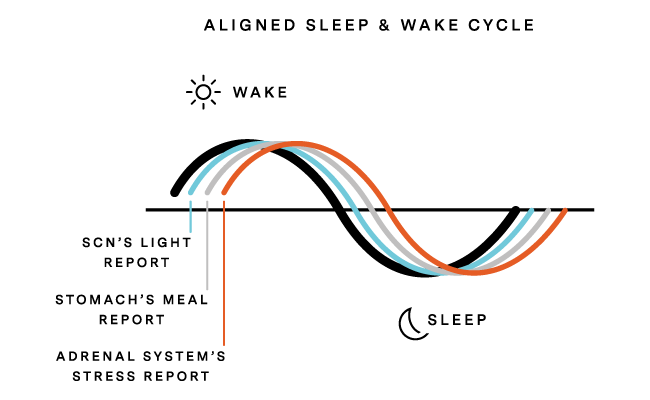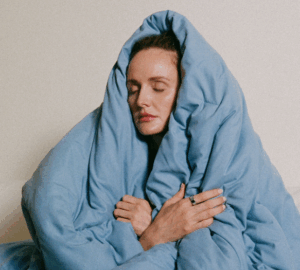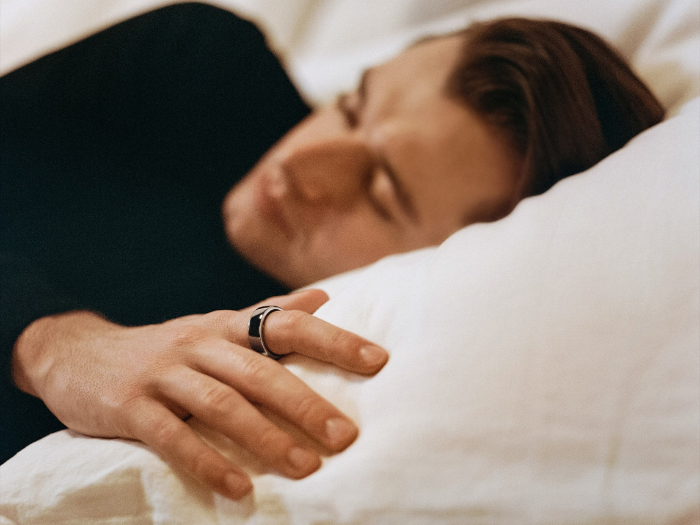- Your body knows when it’s time to sleep based on two key systems: circadian rhythm and the homeostatic sleep drive.
- Your circadian rhythm — basically your internal body clock — tells the brain whether it’s time to stay awake or time to sleep. Lifestyle habits like screen time or caffeine can cause circadian misalignment and lower sleep quality.
- Track your sleep with Oura to learn whether your circadian rhythm is aligned, how much sleep you got in each sleep stage, and much more.
Ever wondered what happens in your brain and body while you’re sleeping? It’s time to find out. Learn how your body regulates sleep, the underlying mechanisms at play, and what happens if they become misaligned.
What Happens in Your Body As You Sleep
A single night’s sleep consists of distinct sleep stages, each characterized by unique patterns of brain activity, eye movements, and physiological and hormonal changes.
| The 4 Stages of Sleep |
Awake: Even though you’re technically awake, there are still sleep-inducing changes occurring:
|
Light sleep:
|
Deep sleep:
|
REM sleep:
|
LEARN MORE: What Are the 4 Stages of Sleep?
How Does Your Body Know When It’s Time to Sleep?
You might think that sleep happens because your body simply runs out of steam. While this is partly true, it’s a lot more complex. There are two major ways that your body knows when it’s time for sleep.
1. Homeostatic sleep drive
This refers to the gradual build-up of the body’s need for sleep. Imagine you’re flipping over an hourglass when you wake up – the increasing amount of sand is your sleep drive. When all the grains of sand run out, your body knows it’s time for sleep.
Adenosine, a neurotransmitter that promotes sleepiness, acts as the homeostatic regulator of sleep. It increases during the day, and peaks at night, helping you feel tired for bedtime. This cycle repeats itself every 24-hour period, much like the circadian rhythm.
2. Circadian rhythm
You have a network of independent internal clocks, found in many organs and cells in the body, collectively referred to as the circadian rhythm system. Based on external cues, like light or food intake, and internal cues, like adenosine levels, these independent clocks report back to your brain when it’s time to sleep.
LEARN MORE: Circadian Rhythms and Your Bedtime
How the Circadian Rhythm Works

This Sleep CEO is a deep brain center that requires feedback from your body’s entire network of clocks to determine whether or not it’s safe to take your systems offline for sleep.
This feedback system consists of clocks (time keepers) and cues (time givers). Cues can originate from your environment (e.g., sunlight) or body (e.g., food entering your stomach).
Cues prompt your internal clocks to either go to sleep or stay awake. The master clock is found in the brain, also called the suprachiasmatic nucleus (SCN).
The job of the SCN is to keep all clocks on a consistent schedule and compile the final daily report for the Sleep CEO to review. The SCN monitors the time from cues in the environment, like light exposure: light keeps you up, the dark makes you sleepy!
Each of your secondary body clocks, or peripheral oscillators, send and receive messages as well. For example, if your stomach receives a cue, like a large deposit of food, it will send a memo to the SCN and other secondary clocks to stay awake.
The SCN is constantly trying to keep all secondary clocks on the same schedule; however, your days vary. This can result in clocks receiving cues at different times and can lead to misalignment (more on this later!).
| Member Tip: Oura members discover their ideal bedtime and chronotype after 90 days of using Oura. This can help you go to bed aligned with your circadian rhythm and a result, get better sleep. |
Your Sleep-Wake Cycle:
Ideally, you want to receive internal and external cues that it’s time to go to sleep, and for you to go to sleep as a result. But it doesn’t always work that way.
Your internal clocks all have their own status reports as to whether it’s time to be awake or asleep. When all of your clocks are aligned, your brain’s job is simpler, resulting in clear patterns of sleeping and waking up. When the reports aren’t aligned, your brain’s sleep center has a difficult time deciding when you should be awake or asleep.
For instance: Your SCN and stomach may have reported a clear pattern of sleeping and waking up (i.e., light exposure and meals at the expected times), but a change in your routine, like a stressful evening meeting, can trigger the secondary clock in your adrenal system to delay sleep. Instead of your 11pm recommended bedtime, you’re only able to fall asleep at 2am. This can cause what’s known as circadian misalignment.


What Causes Circadian Misalignment?
Circadian misalignment can be caused by a number of factors, including:
- Late night workouts
- Blue light exposure
- Eating late at night, particularly sugary foods
- Jet lag
- Shift work
- Daylight savings
- Intense emotions like stress or excitement
| Member Tip: Tag any of these habits on the Oura App using the Tags feature to learn more about how any one of these habits impacts your sleep quality, |
5 Signs Your Circadian Rhythm Might Be Misaligned
1. Your resting heart rate takes a long time to stabilize in the night.
If you are aligned with your body’s internal clocks, your resting heart rate will be at its lowest point in the middle of your sleep. If they are misaligned, your lowest resting heart rate won’t occur until later in the evening. On Oura, this is referred to as your Recovery Index.
2. Your body temperature is elevated in the first half of your sleep.
If your clocks agree, your body temperature will decrease just before sleeping. If they are misaligned, your body temperature may take longer to cool or fluctuate.
3. You take a long time to fall asleep.
Falling asleep should be a relatively quick process after bedtime. If your circadian clock is misaligned, you may have an extended sleep onset – how long it takes you to fall asleep (Sleep Latency on Oura).
Generally, a latency that’s less than 5 minutes may be a sign that you’re overtired, while a latency consistently longer than 20 minutes may signal circadian misalignment.
READ MORE: How to Fall Asleep Fast & Improve Sleep Latency
4. You wake up often in the night.
Circadian misalignment might lead to frequent awakenings during the night, impacting the overall continuity of your sleep. You can see this reflected in your Oura data: lower Sleep Efficiency and Restfulness metrics.
5. You wake up tired (sleep inertia).
When your sleep-wake patterns are in harmony with your circadian rhythm, waking up should bring a sense of alertness and refreshed energy. If misaligned, you may experience sleep inertia – a feeling of grogginess and tiredness upon waking.
LEARN MORE: Why Do I Wake Up Tired? How to Feel More Alert in the Morning
Harness the Science of Sleep for Better Sleep
So, what can you do with this knowledge? While some cues are out of your control (like the sun!), you can create a nighttime routine with clear sleep cues that signal to your internal clocks that it’s time for bed.

Tracking your sleep with Oura can help you leverage the science of sleep to help you develop a sleep-inducing nighttime routine to keep your circadian rhythm aligned. Every day, you’ll get a detailed sleep report on the Oura App that shows how you slept, including specific contributors like sleep latency and sleep efficiency, and how much sleep you got from each sleep stage.
Better sleep starts with science! To start, follow these basic best practices:
- Light: Avoid blue light at least an hour prior to bed.
- Food: Eat lighter meals at night, and stop consuming caffeine and alcohol several hours before bed.
- Activity: Avoid strenuous exercise in the hours leading up to bedtime.
- Arousal: Avoid stressful stimuli, like email or social media, right before bed.
- Body Temperature: Cool your body via a cool room or a hot shower, which encourages your body to cool itself afterward.
LEARN MORE: How Does the Oura Ring Track My Sleep?












